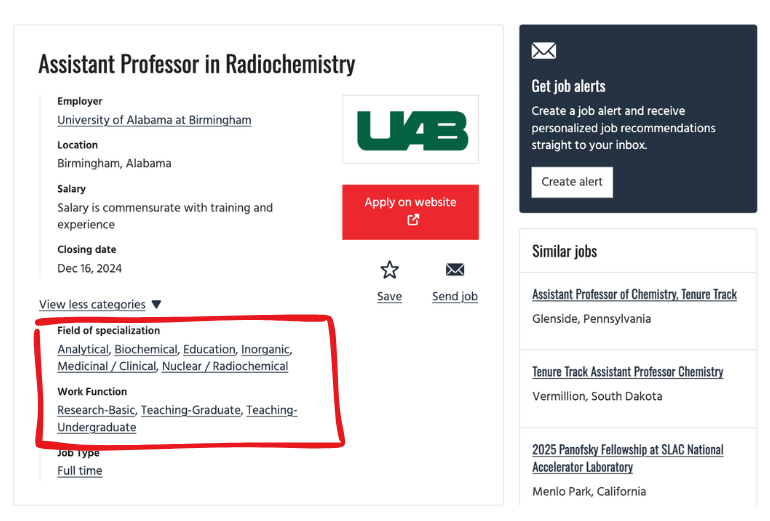Crafting a standout job post is essential when you’re on the hunt for top-tier science talent. The quality of your job description can make or break the caliber of applicants you attract. Did you know that over 50% of job seekers consider the quality of a job post a deciding factor in whether they apply?
But it doesn’t stop there. A well-written job post does more than just draw in applicants—it can also reduce turnover and help you retain your best employees. When candidates clearly understand the role and expectations from the get-go, they’re more likely to be satisfied and stick around.
Moreover, strong employer branding through a polished job description can slash your cost-per-hire by up to 43%. A carefully crafted job post not only showcases your organization’s professionalism and high standards but also boosts your credibility, making you more attractive to the most skilled science professionals out there.
In this guide, we’ll share tips on how to write an exceptional science job post that will help you attract and retain the best talent for your open roles.
Optimize Your Job Post for the Platform it’s Posted On
Creating an effective job posting isn’t just about filling out a form—it’s about strategically crafting a message that reaches the right candidates and stands out in a crowded job market. With numerous job boards catering to the science sector, each with its own set of required fields and options, it’s crucial to tailor your job post to each specific platform.
Start with the Basics: The Job Title
The job title is the first thing job seekers see, and it needs to be clear and searchable. Use relevant scientific and industry-specific keywords to ensure your post appears in the right searches. Stick to straightforward titles like “Process Development Scientist” or “Biochemist” rather than quirky ones like “Scientific Guru” or “Biochem Ninja.” While these fun titles might work in social media posts and some marketing, they can hurt your post’s visibility and keep it hidden from ideal candidates.
Leverage Platform-Specific Features

Once you have a strong job title, make the most of the additional fields and filters that scientific job boards offer.
For example, with ACS recruitment advertising, you can specify the field of specialization, select specific science area filters, and provide detailed information about the work function. Don’t skip these fields or use generic information. Detailed, specific entries can significantly boost your job post’s visibility and help job seekers quickly determine if the role is a good fit for their skills and interests.
By optimizing your job post for the platform it’s on, you not only increase its visibility but also attract the most qualified candidates, ensuring a better fit for your organization.
Find Your Job’s Compelling Hook

Sure, every job post should include detailed information about required skills, preferred experience, and educational backgrounds. Those are essential details. But science is an exciting field that transforms lives and shapes our world on a global scale. Capture the attention of aspiring change-makers by leading with the impact the position will have.
Start your job post with an attention-grabbing hook that highlights the unique and thrilling aspects of the role. Maybe there’s a groundbreaking project the successful candidate will lead or revolutionary new technologies they’ll work with. Follow this by elaborating on the challenges and innovations on the horizon, painting a vivid picture of the transformative impact the employee will have.
Don’t hesitate to use powerful action verbs that leap off the page, like “join our cutting-edge research team and push the boundaries of science” or “drive scientific innovation with our pioneering team.” If the platform allows, pair this dynamic text with visually striking images or video content to bring the role to life.
Format for Clarity: Focus on Readability
Prioritizing clarity is key when providing job information. Aim for a job posting that’s between 300 and 700 words—long enough to cover all necessary details but concise enough to keep the reader engaged.
To enhance readability and effectiveness, structure your job posting in a logical, easy-to-scan format. Use clear section headers and concise bullet-point lists to make the content accessible and engaging.
Transparency and Honesty: Don’t Waste Anyone’s Time
Defining the roles and responsibilities of a position in explicit detail helps ensure that applicants fully understand the scope of the role and what will be expected of them. At the same time, it’s important to be mindful of the qualifications and experience you list as requirements. After all, around 1/3 of job seekers opt out of applying for roles because they feel they lack the necessary skills or credentials, even if they could excel in the position.
Focus on what is truly necessary rather than creating an unrealistic “wish list,” you’re more likely to reach a broader pool of qualified candidates.
Don’t forget to include the location, expectations on remote/hybrid/days in the office, and salary range – these are pieces of core information that candidates will want to know upfront. Transparently sharing salary ranges, benefits packages, and opportunities for advancement gives applicants a concrete sense of the offer as well.
Finally, transparency around the application and interview process is critical. Outlining the steps involved and providing an estimated timeline helps manage candidates’ expectations and reduces frustration. Establishing clear feedback mechanisms, such as notification of application status or opportunities for post-interview reflection, further enhances the candidate experience and shows that you value their time and effort.
Eliminate Bias and Be Inclusive
When crafting job postings and descriptions, it’s crucial to avoid using gendered language or stereotypes. Instead, opt for inclusive pronouns like “they/them” and neutral phrases that don’t make assumptions about a candidate’s gender identity or background. The focus should be solely on the essential qualifications and responsibilities of the role.

Actively encourage a diverse pool of candidates to apply by steering clear of coded language or implicit biases that could discourage certain groups. Highlight your commitment to diversity and inclusion, ensuring all qualified candidates are welcome.
Scientists Love Data: Show Them the Numbers
When it comes to attracting top talent, showcasing tangible data and metrics can be a powerful draw for prospective job seekers. Providing clear, quantifiable information about the scope and scale of projects, the funding and resources available, and the size of the teams they’ll be working with sends a strong signal about your organization’s stability, ambition, and ability to support employees.
Example:
Lead a vibrant team of over 50 researchers with access to state-of-the-art facilities, including our new $50 million lab space, plus secure funding with an annual project budget of up to $10 million.
Additionally, sharing hard numbers on past achievements, such as key performance indicators, growth rates, or awards won, helps candidates envision the impact they could make. Outlining ambitious goals, expansion plans, or upcoming product launches demonstrates momentum and opportunities for growth.
Spotlight Culture
When job hunting, a company’s culture is consistently cited as the most important factor for prospective candidates. In fact, 88% of job seekers say a healthy work culture is crucial for their success and satisfaction. 86% of candidates say they won’t even apply to companies with a bad reputation for their employee culture. That’s why it’s essential to clearly articulate your organization’s values, mission, and work environment during the recruitment process.
Find ways to highlight the collaborative and supportive aspects of your team structure. Consider including data on high retention rates or employee survey stats. The most effective employer branding strategies feature stories, quotes, and personal experiences directly from current employees. This approach allows prospective hires to vividly imagine themselves as part of the organization and culture.


















